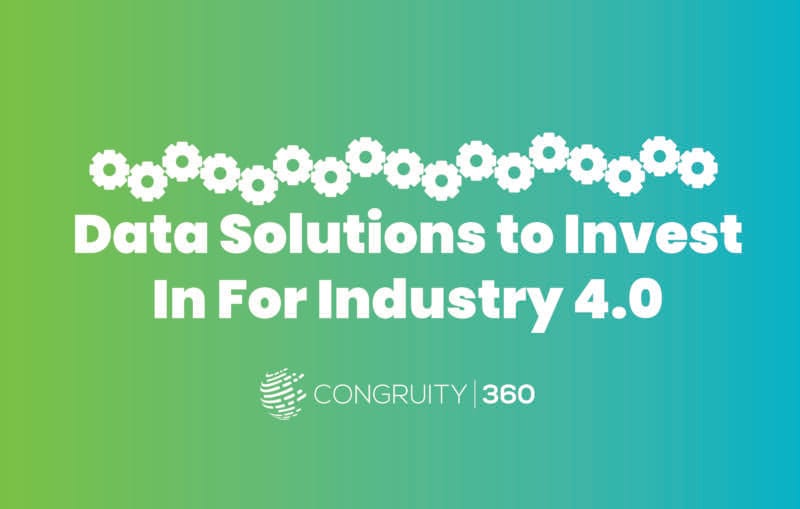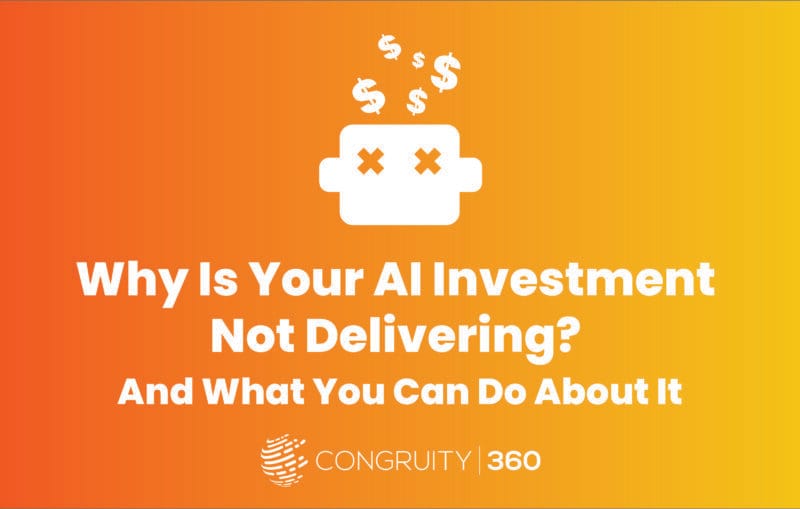Struggling with messy, inconsistent data? Without a reliable data cleaning process, your organization is exposed to costly compliance risks and flawed analytics
We understand it’s frustrating to sift through mountains of inaccurate enterprise data, only to find that critical business decisions hinge on incomplete or erroneous information.
Fortunately, data cleaning solutions from Congruity360 empower you to automate error detection, maintain compliance standards, and optimize storage costs. In this guide, we’ll explore exactly how to achieve reliable, compliant, and analytics-ready data at scale—so you can focus on driving strategic value
Data, in its raw form, is often messy and unstructured. It’s filled with inaccuracies, inconsistencies, and redundancies that can severely compromise the results of any analysis. Data cleaning is the process of sifting through this raw data, identifying these errors, and rectifying or eliminating them. This vital process ensures that the data is accurate, consistent, and usable for analysis and regulatory compliance
Understanding Data Cleaning for Enterprise Needs
Understanding the process of data cleaning is crucial to ensuring the quality and reliability of your data , especially for organizations facing strict regulatory requirements. Each step in the data cleaning process is iterative, meaning it may be repeated several times until the data is of the highest possible quality for analysis and decision-making within enterprise data cleaning workflows.
Data Auditing Techniques (ISO & IEEE Standards)
Data auditing is the very first step in the data cleaning process. Raw data is thoroughly examined using statistical methods and database techniques to detect any anomalies, inaccuracies, or inconsistencies. According to ISO 8000 guidelines, organizations with standardized data processes see a 25% reduction in compliance issues. These standards provide a framework for ensuring data quality throughout the enterprise lifecycle.
Workflow Specialization (Python, R Integration)
Workflow specialization involves tailoring data cleaning processes to suit the specific requirements of the dataset and the objectives of the data analysis. In Python, you can use libraries like Pandas to automate the data cleaning process, while R offers packages such as tidyr and dplyr for efficient data manipulation. This could mean implementing particular techniques or tools optimized for certain types of errors or discrepancies through advanced data classification tools.
Specialized workflows may include:
- Imputation methods for handling missing values
- Normalizing numeric fields for consistent analysis
- Outlier detection and handling strategies
Explore Our Automated Data Classification to see how Congruity360 streamlines these processes.
Workflow Execution (Automated vs. Manual)
Workflow execution is the stage where the data cleaning processes that have been planned and specialized are put into action. It involves implementing the designed strategies to detect and handle inconsistencies, missing values, duplicate entries, and other potential errors in the dataset. Enterprise-scale data requires automated workflow execution to efficiently manage the volume and complexity of information.
Like many data leaders, you’re probably concerned that overlooked inaccuracies could expose your organization to regulatory scrutiny or harm your team’s confidence in analytics. Automated workflow execution significantly reduces this risk.
Post-processing and Controlling
Post-processing and controlling is the final stage of the data cleaning process but is no less critical than the preceding steps. In this phase, the cleaned data is thoroughly evaluated to determine the effectiveness of the cleaning process and to identify any residual errors that may have been overlooked. This step is essential for ensuring risk-based data governance and multi-jurisdictional compliance audits are satisfied.
Key Characteristics of Clean Data
Recognizing clean data involves understanding its key characteristics. These characteristics are:
- Accuracy: Data accurately represents the real-world entities or events it describes
- Completeness: All required data is present without gaps
- Consistency: Data values are uniform across datasets without contradictions
- Timeliness: Data is current and updated within acceptable timeframes
- Uniqueness: No unnecessary duplications exist in the dataset
- Validity: Data conforms to required formats, ranges, and business rules
Imputation, Normalization, and Outlier Detection
Methods like imputation and outlier detection can drastically reduce errors in your enterprise datasets. Imputation refers to the process of replacing missing values with substituted values, while normalization ensures consistent scales across different data ranges. These techniques form the foundation of data readiness for analytics and ensure your data meets rigorous compliance standards.
Ensuring Accuracy & Compliance Readiness
Clean data isn’t just accurate—it’s compliance-ready. This means your data must adhere to industry standards like GDPR, HIPAA, or FINRA regulations. According to a recent Forbes Tech Council report, organizations with robust data cleaning protocols are 45% less likely to face compliance penalties.
Validating Your Data: Practical Steps for Compliance
Validating the cleanliness of your data involves several steps and practices. The first step is visual inspection, where you manually review a portion of your dataset to spot any glaring errors or inconsistencies. Though this method is not thorough, it can give you an initial sense of the data’s quality.
Every overlooked error risks compliance fines that can cost millions—don’t leave your auditing to chance. Enterprise organizations should implement automated data validation processes that can scan entire datasets for anomalies and inconsistencies.
We know it’s overwhelming to manage endless streams of enterprise data while ensuring it meets tight compliance standards across multiple jurisdictions. Congruity360’s validation tools offer comprehensive scanning capabilities that integrate with your existing data workflows.
Overcoming Challenges of Data Cleaning at Scale
Despite the critical importance of data cleaning, it is not without its challenges. One of the significant challenges involves the sheer volume of data that businesses manage today. The increasing magnitude of data leads to a corresponding increase in the complexity of the cleaning process , particularly when dealing with unstructured data cleaning strategies.
Risk Exposure & Regulatory Consequences
The stakes for enterprise data cleaning extend far beyond operational inconvenience. Data privacy regulations like GDPR, CCPA, and industry-specific frameworks pose significant risk exposures tied to unclean data. Organizations face potential fines of up to 4% of global annual revenue for serious data violations.
It’s perfectly normal to feel stressed about whether your data is fully compliant—especially when stakeholders demand trustworthy analytics for real-time decisions. This is where automated compliance solutions become essential.
Discover your organization’s vulnerability to data compliance issues
Manage Your Data with Congruity360’s Automated Solutions
As businesses grapple with the challenges of data cleaning, it becomes crucial to leverage advanced tools and services like Congruity360. Join the hundreds of enterprise organizations that rely on Congruity360 to protect and optimize their mission-critical data. Our enterprise data cleaning solutions transform risk into opportunity through:
- Intelligent classification that automatically identifies sensitive information
- Automated compliance workflows that reduce manual intervention
- Risk-based data governance that prioritizes your most vulnerable assets
- Storage optimization that reduces costs while maintaining compliance
We’ve been in your shoes—struggling to reconcile multiple data sources—and discovered that the right automated solutions drastically simplify data governance.
How One Fortune 500 Company Reduced Compliance Costs by 30%
“Congruity360’s automated classification saved us countless hours of manual data review and significantly reduced our risk exposure.” – CIO, Global Financial Services Firm
Industry Applications (Healthcare, Finance, Etc.)
Different industries face unique data cleaning challenges and compliance requirements. In the healthcare sector, data cleaning ensures accurate patient records and compliance with HIPAA regulations. Financial institutions must adhere to regulations like FINRA and SOX, which demand meticulous data accuracy for transaction records and customer information.
Over the past decade, data cleaning has evolved from manual processes to automated machine learning workflows that can handle the scale and complexity of enterprise data. Organizations that implement these advanced techniques see an average of 40% reduction in data-related errors and compliance issues.
Governance, Risk & Compliance Solutions from Congruity360 are tailored to address these industry-specific challenges while maintaining a unified approach to data governance.
Advanced Data Cleaning Methods
Enterprise data cleaning has moved beyond basic spreadsheet operations to sophisticated algorithms and automation pipelines. These advanced methods not only improve data quality but also significantly reduce the time and resources required for maintaining compliance.
Machine Learning Algorithms
Modern data cleaning leverages machine learning algorithms to detect anomalies and patterns that would be impossible to identify manually. Using Python’s scikit-learn library or specialized enterprise tools, organizations can train models to automatically flag outliers or inconsistencies across massive datasets.
Automating Data Pipeline
Tools like Apache Airflow and Kafka enable organizations to create continuous data cleaning pipelines that process information as it enters the system. These pipelines can include validation checks, transformation rules, and automated alerts for compliance issues, ensuring data remains clean throughout its lifecycle.
Additional Resources & Related Posts
Explore these additional resources to deepen your understanding of data governance and cleaning strategies:
- AI & Data Policy Risks: Understanding the intersection of AI and data compliance
- Future Trends in Data Analytics: Preparing for emerging challenges in data management
Subscribe to Get More Data Gov Insights
Stay informed about the latest developments in data governance, compliance, and cleaning strategies.
Ready for Advanced Data Cleaning? Talk to Our Experts
As a strategic data leader, your success depends on trusted, compliance-driven data solutions. Let’s discuss how Congruity360 aligns with your vision.





